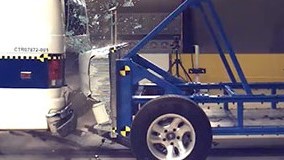Key points
- Crash testing measures a vehicles' ability to withstand impact during an actual crash.
- Ambulance crash testing aims to improve the safety of the patient compartment.
- NIOSH partnered with the Department of Homeland Security's Science and Technology Directorate and others to conduct ambulance crash tests.

Why it's important
Crash testing is a controlled way of crashing a vehicle to measure its ability to withstand impact during an actual crash.
Ambulance crash testing aims to protect Emergency Medical Services (EMS) clinicians and their patients during transport by improving ambulance safety.
Did you know?
Crash test methods
The Society of Automotive Engineers (SAE) published 10 test methods. These methods are identified below. They cover everything from seat belts to the patient compartment structure.
- SAE J2917: Crash pulse from frontal impact
- SAE J2956: Crash pulse from side impact
- SAE J3026: EMS worker seating and restraints integrity
- SAE J3027: Patient cot, floor mount, and restraint system
- SAE J3043: Ambulance equipment mount devices and systems
- SAE J3044: Crash pulse from rear impact
- SAE J3057: Modular body (or box style) integrity
- SAE J3058: Storage compartment integrity
- SAE J3059: Measurement of EMS worker head movement during a crash event
- SAE J3102: Floor integrity test to support the patient cot
Ambulance crash test methods infographic
Crash test impacts
Changes to ambulance design, testing, and manufacturing impact the:
- Layout of the ambulance patient compartment
- Contents in the ambulance patient compartment (e.g. seats)
- Outside or body of the ambulance
Data from crash testing allows engineers to better understand how the structure reacts during a crash. These data also allow engineers to design safer structures and equipment.
Using crash test data
Ambulance builders and major component suppliers can design and test their vehicles, seats and cots, and other devices to improve occupant safety during a crash.
Those responsible for designing or purchasing ambulances for a service should familiarize themselves with crash test methods and Ambulance Patient Compartment Human Factors Design Guidebook.1
These resources can help design a compartment that meets the needs of a particular service while improving worker safety and patient care.
Crash test video series
NIOSH and the Department of Homeland Security's Science and Technology Directorate produced a 7-part video series. The series provides test methods and considerations when purchasing or building an ambulance, new crash test methods to improve worker and patient safety in an ambulance patient compartment, and an overview of the changes impacting ambulance design, testing, and manufacturing.
Improving EMS safety through ambulance design & testing
- Department of Homeland Security, Science and Technology Directorate [2015]. Ambulance Patient Compartment Human Factors Design Guidebook
